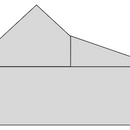We’re planning a gut remodel our Hawaii home (Zone 1) and considering insulation options and how best to keep our house as cool as possible without any A/C. Since Hawaii is full of micro-climates I’ll add that it never gets cold where we live, but we experience lots of rain and humidity.
Our roof framing is a bit unique and broken up into two rectangular spaces – a large gable (~6/12 pitch) and a much lower sloped (~2/12) roof breaking off the middle of the eave end of the gable section (See attachment. Not to scale whatsoever). Roofing material is shingles on the gable side and modbit on the lean-to side. No radiant barrier or insulation in the roof itself at this point.
For attic ventilation, there are two large gable vents that are oriented in the direction the trade winds blow and seem to get plenty of breeze. No ridge vent and eaves are open on the outside (exposed rafters) with small round intake vents.
There’s no insulation in the attic at the moment.
Here are the different ideas we’re considering…
Insulate the ceiling floor with Rockwool batts
While considering this option we worried that we’d be blocking the airflow from the eave intake vents. Baffles seem like the usual suggestion to fix this problem, but wondering if they are necessary in our climate or if we can just cut the Rockwool short towards the eaves. We test fit some plastic rafter baffles and they seemed to reduce the airflow (forgive the very unscientific assessment, but it just seems like the airflow is more limited than it would be without them).
One downside of laying Rockwool on the lean-to eave end of the ceiling is that there’s not much room to put anything down without blocking off the intake vents (the trade winds blow in that direction so we want to take advantage of the natural cooling).
Another concern is that putting insulation in the ceiling only could lead to the attic area becoming a “furnace” trapping heat between the roof and ceiling. One builder mentioned this to us in passing, but we are skeptical of that advice.
Insulate below the roof with Rockwool batts
While considering this option we had a similar question about whether baffles should be used. We like this roofing deck option better since it seems “cleaner” (no electrical to work around). I read somewhere that insulating the ceiling is “better” (but didn’t get a clear explanation about why and presume it might have to do with AC efficiency as you end up with a smaller conditioned space). If we went in this direction without baffles we would consider cutting the Rockwool short of the eave intake vents.
Main question….
Does roof or ceiling insulation placement make a difference in a cooling climate where no AC will be used?
Alternate idea… blown-in insulation for the ceiling
We’re also considering this, but brings us back to the baffling question about baffles. The baffles seem like a must for blown-in otherwise we’d block off the eave intake vents. This plan is less attractive to us since we are not comfortable DIY-ing it and also not sure if blown-in is a good choice for the lean-to side of the house. Would we even be able to get the insulation into such a tight space? Attic access is fairly limited and the lumber used in our unique roof design seems like it would make it difficult to maneuver.
Thanks!










Replies
Understand this insulation can’t save you any money since it seems you nether heat nor cool your home.
The insulation could delay the houses warming on sunny days by a few hours but then the attic will hold the heat longer into the evening for a few hours. My guess is the peak temp would be lower but the 24 hour average would be unchanged depending on how well the attic is ventilated and I am guessing no ridge vent so not much venting.
Walta
Thanks for the reply and thoughts. We understand we won't be saving money as we have no plans to add A/C and heat is not necessary. Our goal is mainly to avoid unbearable heat in the summer months. Many grow up in houses here without insulation or adequate ventilation and are trying to do what we can to avoid that. Correct that there's no ridge vent. Just large gable vents and eave vents.
Gabel vents can be very effective.
It can’t hurt to add some insulation but keep 2 inches or so to allow air to flow from the soffits to the gable vents.
Walta